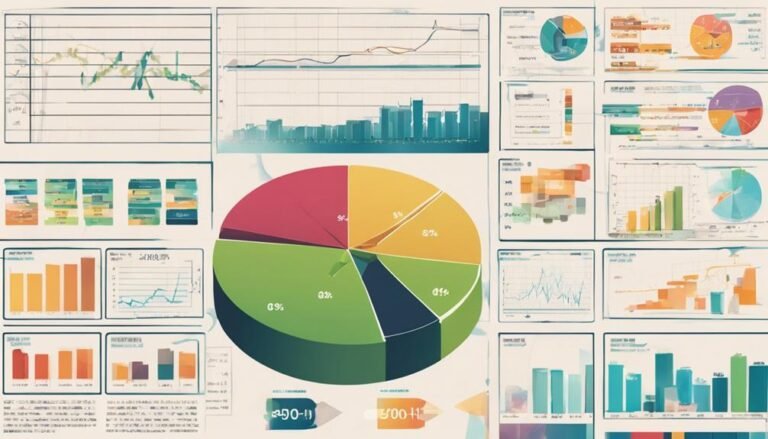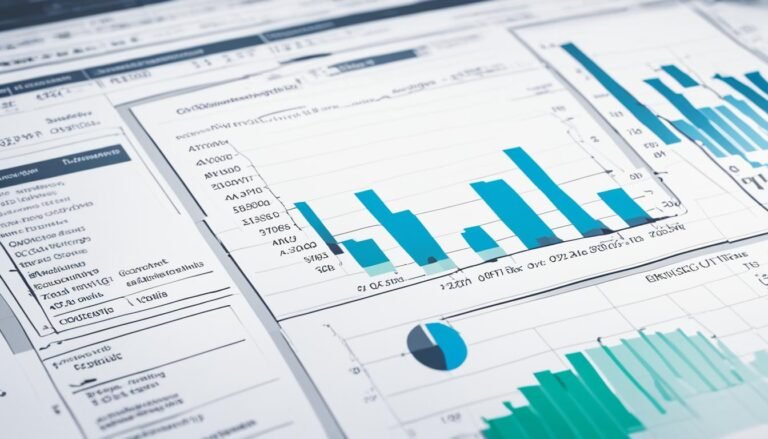Financial Econometrics: Unveiling Market Dynamics
Econometrics, a powerful discipline that combines economic theory, statistical analysis, and mathematics, plays a crucial role in unraveling the complexities of market dynamics. By leveraging rigorous statistical models and economic principles, financial econometrics provides insights into hidden patterns, enabling better decision-making and risk management in the ever-changing financial landscape. This article explores the significance of financial econometrics, its applications in market microstructure analysis, and the advantages it offers in forecasting and risk management. Let’s delve into the world of financial econometrics and unlock the keys to understanding and thriving in today’s intricate market dynamics.
Key Takeaways:
- Financial econometrics combines economic theory, statistical analysis, and mathematics to study market dynamics.
- It helps uncover hidden patterns, quantify relationships, optimize trading strategies, and manage risks.
- Market microstructure analysis focuses on order flow, liquidity, price dynamics, and volatility.
- Econometric techniques such as event studies, time series analysis, regression analysis, and GARCH models are used to analyze market data.
- Applications of econometrics in market microstructure analysis include liquidity measures, price movements, market efficiency, and forecasting.
Understanding Market Microstructure
Market microstructure plays a crucial role in the functioning of financial markets. It involves the intricate processes and dynamics by which market participants interact, trade assets, and determine prices. Within this framework, factors such as liquidity, order types, trading platforms, market impact, and volatility shape the market structure and influence trading outcomes.
At the heart of market microstructure is liquidity. Liquidity represents the ease with which an asset can be bought or sold without significantly affecting its price. High liquidity allows traders to execute their orders quickly and at a fair price, while low liquidity can lead to price slippage and increased transaction costs.
Traders utilize different order types to navigate the market microstructure. Market orders, for example, allow traders to buy or sell an asset at the prevailing market price, while limit orders allow them to specify a maximum buy price or a minimum sell price. By understanding and strategically employing these order types, traders can better achieve their trading objectives.
Electronic trading platforms have revolutionized market microstructure by facilitating the seamless execution of trades. These platforms provide traders with access to a wide range of financial instruments and markets, enabling efficient and transparent trading. They also offer advanced order routing functionalities and real-time market data, empowering traders with valuable insights.
When an order is executed, it can have a substantial impact on the market. Large trades can lead to price movements, known as market impact, as the order is matched with available liquidity. Understanding and quantifying market impact helps traders gauge the potential price slippage and adjust their trading strategies accordingly.
Finally, the concept of volatility is essential in market microstructure analysis. Volatility refers to the degree of price fluctuations in a given security or market. Traders and investors carefully monitor volatility as it can indicate the level of risk and uncertainty. Econometric models are often employed to measure and forecast volatility, allowing market participants to make more informed decisions.
Overall, an in-depth understanding of market microstructure is crucial for traders, investors, and financial professionals. It helps them navigate the complexities of the market, optimize trading strategies, and make informed decisions that maximize returns and mitigate risk.
What is Econometrics?
Econometrics, an amalgamation of statistical analysis and economic theory, is a powerful discipline that unveils the intricacies of economic phenomena. In the context of market microstructure analysis, econometrics provides analysts with valuable insights into the relationship between various market variables. By employing statistical models and economic theory, econometrics enables the measurement and quantification of complex relationships and dependencies in the market. It plays a pivotal role in optimizing trading strategies, risk management, and policy implications.
With its foundation in statistical analysis, econometrics equips analysts with the tools to uncover hidden patterns and understand the dynamics of market microstructure. By quantifying relationships between market variables, econometric models offer a comprehensive view of the complex interactions that shape the financial landscape.
Moreover, econometrics enables the development of robust forecasting models based on historical data. These models help analysts anticipate market trends and make informed decisions. Through careful statistical analysis of economic variables, econometrics empowers businesses and policymakers to adapt their strategies in an ever-changing environment.
Market microstructure analysis demands a deep understanding of economic theory, and econometrics provides the framework necessary to explore and interpret its intricacies. By combining economic principles with statistical techniques, econometrics offers a nuanced perspective on the behavior of market participants and the forces that shape market dynamics.
| Econometrics | Advantages |
|---|---|
| Statistical analysis | Unveils hidden patterns in market microstructure |
| Economic theory | Quantifies relationships between market variables |
| Risk management | Optimizes trading strategies |
| Policy implications | Guides decision-making in the financial landscape |
By bridging the gap between statistical analysis and economic theory, econometrics unravels the complexities of the market. Through its rigorous methods, it equips analysts with the tools necessary to gain valuable insights and make data-driven decisions.
Econometric Techniques for Market Microstructure
In market microstructure analysis, various econometric techniques are employed to uncover hidden patterns and gain insights into market dynamics. These techniques enable analysts to make informed decisions and optimize strategies. Some of the commonly used econometric techniques in market microstructure analysis include:
Event Studies
Event studies are used to analyze the impact of specific events on financial markets. By examining the market’s reaction to events such as corporate announcements or policy changes, analysts can assess the influence of these events on market variables. This analysis helps quantify the market response and understand the underlying mechanisms driving the market.
Time Series Analysis
Time series analysis is utilized to study patterns, trends, and seasonality in market variables. By analyzing historical data, economists can identify long-term trends and cyclical patterns in market behavior. This information is valuable for forecasting and understanding the dynamics of market variables over time.
Regression Analysis
Regression analysis is a widely used technique for estimating the relationship between dependent and independent variables. In market microstructure analysis, regression analysis helps quantify the impact of various factors on market variables. By studying the statistical relationship between different market variables, analysts can gain insights into market dynamics and make informed decisions.
GARCH Models
GARCH (Generalized Autoregressive Conditional Heteroskedasticity) models are commonly employed to model and forecast volatility in financial markets. These models capture the time-varying nature of volatility and allow for the estimation of potential risk. By understanding and forecasting volatility, analysts can better assess potential market fluctuations and manage risk effectively.
These econometric techniques form the building blocks of market microstructure analysis and provide valuable insights into market dynamics, risk management, and forecasting. By employing these techniques, analysts can make data-driven decisions and gain a competitive edge in the financial landscape.
Applications of Econometrics in Market Microstructure Analysis
Econometrics plays a crucial role in market microstructure analysis, offering valuable insights into various aspects of financial markets. By applying econometric techniques, analysts can explore liquidity measures, model price movements, assess market efficiency, and forecast future market trends.
Evaluating Market Liquidity Conditions
One of the key applications of econometrics in market microstructure analysis is the estimation of liquidity measures. By analyzing bid-ask spreads and market depth, econometric models can provide valuable insights into market liquidity conditions. These measures help market participants assess the ease of buying or selling an asset without causing significant price changes, allowing for informed trading decisions.
Modeling Price Movements
Econometrics enables analysts to model price movements by capturing the relationship between various market factors. By identifying and quantifying the influence of variables such as trading volume, market volatility, and economic indicators, econometric models help explain and predict price changes. This information is vital for traders, investors, and policymakers in understanding market dynamics and formulating effective strategies.
Evaluating Market Efficiency
Market efficiency refers to the speed and accuracy with which prices adjust to new information. Econometrics plays a vital role in evaluating market efficiency by analyzing the statistical significance of price adjustments and examining the impact of trading costs on price efficiency. This assessment helps market participants identify opportunities for arbitrage, assess the effectiveness of investment strategies, and make informed trading decisions.
Forecasting Future Market Trends
One of the key advantages of econometrics in market microstructure analysis is its ability to forecast future market trends. By leveraging historical data, econometric models can estimate future price movements, volatility, and other market variables. This forecasting capability enables businesses to plan and strategize effectively, anticipate market conditions, and make informed decisions about investment, risk management, and resource allocation.
Overall, the applications of econometrics in market microstructure analysis are extensive and far-reaching. From evaluating liquidity measures to modeling price movements, assessing market efficiency, and forecasting future trends, econometrics provides valuable insights into the complex dynamics of financial markets. By leveraging these insights, market participants can optimize their strategies, mitigate risks, and make well-informed decisions in the ever-changing financial landscape.
Advantages of using Financial Engineering in Market Microstructure Analysis
Financial engineering, a multidisciplinary field combining mathematics, statistics, and finance, offers several advantages in the realm of market microstructure analysis. By leveraging its techniques and tools, financial professionals can gain valuable insights into market dynamics and optimize trading strategies.
Accurate Pricing of Derivatives
One of the key advantages of financial engineering in market microstructure analysis is the ability to accurately price derivatives. Derivatives are financial instruments whose value is derived from an underlying asset, and their pricing plays a crucial role in understanding their impact on market dynamics. Through sophisticated mathematical models and statistical analysis, financial engineering enables the precise valuation of derivatives, allowing market participants to make informed decisions regarding their trading strategies and risk exposure.
Risk Management
Another significant advantage of financial engineering is its focus on assessing and managing risk. Risk is an inherent aspect of financial markets, and understanding and mitigating risk is vital for successful trading. Financial engineering provides techniques and methodologies to evaluate the potential downside associated with various trading strategies. By quantifying and analyzing risk factors, such as market volatility and correlation, financial professionals can make informed decisions and develop risk management strategies to protect their portfolios.
Algorithmic Trading Strategies
Financial engineering also plays a vital role in the development of algorithmic trading strategies. Algorithmic trading involves the use of computer algorithms to execute trades at high speeds and volumes, leveraging statistical models and mathematical optimization techniques to identify profitable trading opportunities. By using financial engineering techniques, such as statistical analysis and optimization methods, traders can design and implement algorithmic trading strategies that capitalize on market inefficiencies and generate consistent returns.
Advancements in Financial Engineering for Precise Market Microstructure Analysis
Advancements in financial engineering have revolutionized the field of market microstructure analysis. Financial professionals now have powerful tools and techniques at their disposal to analyze market dynamics, model complex financial instruments, and design trading strategies with precision and accuracy. These advancements have significantly enhanced the predictive power of financial models and improved risk management techniques, leading to optimized trading strategies and better decision-making.
One area where financial engineering has made significant contributions is in risk management and insurance. By leveraging advanced statistical models, financial professionals can evaluate risk, estimate probabilities of events, and determine appropriate premium rates. This enables insurers to develop robust risk management strategies and offer products tailored to meet the evolving needs of their clients.
Another key application of financial engineering is in forecasting and business planning. By utilizing sophisticated econometric models, businesses can make accurate predictions about future market trends, enabling them to plan their operations and strategies effectively. Financial engineering techniques help businesses identify potential risks and opportunities, allowing for informed decision-making and proactive business planning.
Overall, advancements in financial engineering have brought about a new era of precision in market microstructure analysis. By harnessing the power of these techniques, financial professionals can gain deep insights into market dynamics, enhance risk management practices, and make data-driven decisions to thrive in the competitive business landscape.
Understanding Consumer Behavior with Econometrics
Econometrics plays a pivotal role in understanding consumer behavior, helping businesses and policymakers make informed decisions. By analyzing data on consumer preferences, purchasing patterns, and socioeconomic factors, economists can identify key determinants of demand.
Using econometric models, businesses can predict the impact of price changes on consumer demand and evaluate the effectiveness of marketing strategies. This enables companies to tailor their offerings to meet consumer needs, leading to more targeted and efficient business practices.
Understanding consumer behavior through econometrics allows businesses to gain valuable insights into consumer preferences and trends, enabling them to make data-driven decisions that optimize their marketing efforts and improve customer satisfaction.
By leveraging econometric analysis, businesses can develop a deep understanding of their target market and gain a competitive edge in the industry. Econometrics provides valuable insights that go beyond surface-level observations, allowing companies to uncover hidden patterns and factors that influence consumer behavior.
Econometrics also helps businesses measure the effectiveness of their marketing strategies. By analyzing the impact of different marketing initiatives on consumer behavior, businesses can optimize their marketing budgets and allocate resources to strategies that yield the highest returns.
Ultimately, understanding consumer behavior through econometrics allows businesses to stay ahead in the ever-changing market landscape. It empowers companies to make informed decisions based on data, resulting in improved customer satisfaction, increased market share, and sustainable growth.
Example
For example, let’s consider a company that sells skincare products. By utilizing econometric techniques, the company can analyze consumer data to identify the factors that drive demand for their products. They may find that factors such as age, income, and social media influence purchasing decisions.
The Impact of Marketing Strategies
Econometrics can also help the company evaluate the impact of different marketing strategies. For instance, they can assess the effectiveness of online advertisements, influencer partnerships, or discounts on consumer behavior. By measuring the changes in demand associated with these strategies, the company can make data-driven decisions to optimize their marketing efforts.
The image above illustrates the vast amount of data that can be analyzed using econometric methods to gain insights into consumer behavior. By examining this data, businesses can uncover valuable information that can guide their marketing strategies and drive business success.
Personal Finance and Investment Decisions with Econometrics
Econometrics, with its statistical models and analytical techniques, can be a valuable tool for individuals looking to navigate the complexities of personal finance and make informed investment decisions. By incorporating econometric methods, individuals can assess the risk and return characteristics of different investment options, optimize their portfolios, and strategically allocate their assets for long-term financial growth.
One of the key advantages of using econometrics in personal finance is the ability to assess the risk associated with various investment strategies. By analyzing historical data and applying statistical models, individuals can identify potential risks and evaluate how different investment decisions might impact their long-term financial goals. Econometric techniques such as regression analysis and time series modeling allow for a comprehensive risk assessment and enable investors to make data-driven choices.
Moreover, econometrics plays a crucial role in determining the optimal asset allocation for individuals’ investment portfolios. By analyzing historical performance, correlations, and future projections of various asset classes, econometric models can help individuals construct diversified portfolios that minimize risk and maximize returns. These models take into account factors such as expected returns, volatility, and correlation among different asset classes to create a well-balanced investment strategy.
Here’s an example of a table showcasing the historical performance and risk measures of different asset classes:
| Asset Class | Average Annual Return | Volatility | Correlation with S&P 500 |
|---|---|---|---|
| Stocks | 8% | 12% | 1 |
| Bonds | 4% | 8% | 0.3 |
| Real Estate | 6% | 10% | 0.6 |
| Commodities | 2% | 20% | -0.1 |
This table provides valuable information on the average annual returns, volatility, and correlations of different asset classes. It allows individuals to make informed decisions about asset allocation based on their risk tolerance and investment objectives.
Using econometric techniques, individuals can also estimate future performance and forecast the potential returns of different investment options. By analyzing historical trends and incorporating relevant market information, econometric models can provide insights into the future performance of various assets or investment strategies. This enables individuals to make informed decisions and adjust their investment strategies accordingly.
By utilizing econometrics in personal finance and investment decisions, individuals can make more informed choices, mitigate risk, and optimize their portfolios for long-term financial success. The analytical tools offered by econometrics provide valuable insights into market dynamics, risk assessment, and asset allocation, empowering individuals to navigate the financial landscape with confidence.
Conclusion
Econometrics is a powerful tool that empowers individuals and organizations to make informed, data-driven decisions in the financial landscape. By applying statistical models and economic theory, econometrics uncovers hidden patterns in market data and provides invaluable market insights. Whether it is understanding market microstructure, analyzing consumer behavior, or making investment decisions, econometrics plays a crucial role.
Through econometrics, individuals and organizations can optimize their strategies and enhance decision-making processes. By leveraging data, econometrics helps identify market trends, quantify relationships between variables, and forecast future market dynamics. This enables businesses to adapt to the ever-changing financial landscape and gain a competitive edge.
Furthermore, econometrics facilitates effective risk management by providing tools and techniques to assess and mitigate risks. It allows for the measurement and quantification of market variables, aiding in the evaluation of potential risks and the development of risk management strategies.
In conclusion, embracing econometrics enables individuals and organizations to make more informed and data-driven decisions, gain valuable market insights, and navigate the complexities of the financial landscape. By leveraging statistical models and economic theory, econometrics enables better decision-making, optimization of strategies, and ultimately, success in the market.







